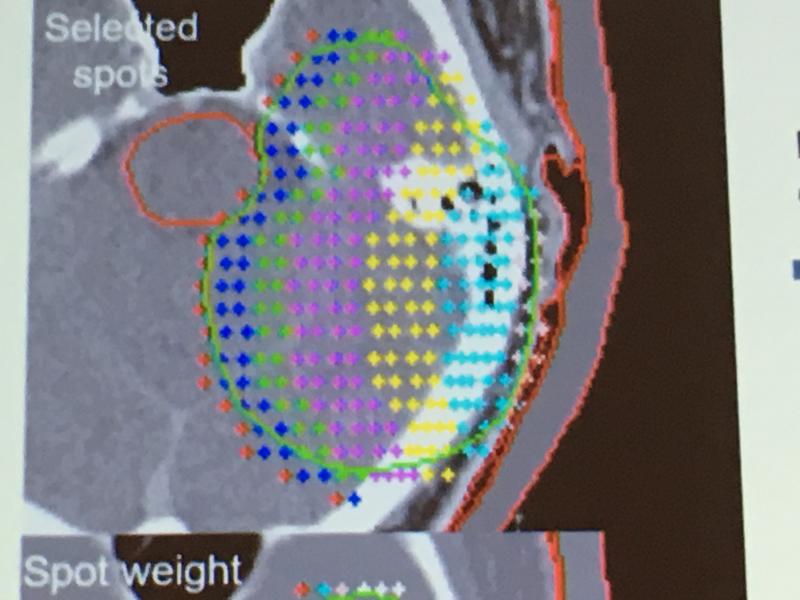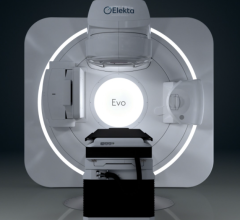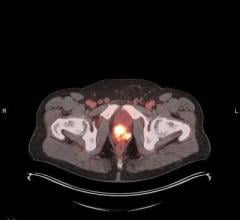
A model of the new, compact, single-room Varian ProBeam 360 system. The system is an example of the trend in proton therapy toward single-room, smaller systems and away from multi-room treatment centers.
A few of the big takeaways from the American Society of Radiation Oncology (ASTRO) 2018 meeting in October were industry trends and advances in proton therapy technology. The key messages are that proton therapy systems are getting smaller, pencil beam therapy will likely become the standard of care in the coming years, and two new treatment methods may significantly cut treatment times and improve outcomes.
The Shrinking Size of Proton Systems
In speaking with vendors and according to experts in sessions, the trend in proton therapy has definitely swung toward smaller, compact, single-room proton therapy system installations and a movement away from large, multi-room treatment centers. This is in part due to the high cost of building a proton therapy center, which includes not just the system, but a specially tailored building to be constructed for the system to reside in.
In speaking to Aymeric Harmant, IBA's global marketing director for proton therapy, over the past year IBA and the other proton therapy vendors have reported only single-room system contracts being signed. The main reason for this is the cost of these systems and issues with getting enough referrals to make the systems profitable. He said one-room systems cost about $20 million and about $15 million more for the building. Multi-room systems cost upwards of $80 million. The vendors' ability to create smaller-footprint cyclotrons has helped make smaller systems possible.
At ASTRO, Varian introduced its new ProBeam 360 system, a single-room system that is 30 percent smaller than Varian’s previous-generation proton therapy system. The vendor also said the smaller footprint means the system can reduce vault construction costs by about 25 percent.
In addition to smaller, single rooms, the technology is being simplified to make it easier for hospitals to use. "About 90 percent of people at ASTRO do not do proton therapy, so we are trying to show them that proton therapies are not as complex as they were 10 years ago," Harmant explained.
The Movement to Pencil Beam Proton Therapy
In sessions, several speakers noted that proton therapy is moving rapidly toward pencil beam scanning (PBS) therapies and that all new systems being installed are pencil beam-capable. Speakers said pencil beams are easier to work with and more exact as to where the dose is being delivered, eliminating the need for traditional collimation. It also enables intensity modulated proton therapy (IMPT).
Two New Methods to Speed Proton Therapy
However, with a single treatment room, facilities are looking at how to increase patient throughput, especially as patient volume grows. Two new solutions to speeding up proton therapy were displayed as works in progress by Varian and IBA.
Varian announced at ASTRO it is working on a way to deliver a single-fraction, one-second, very-high dose of protons to a tumor to enable a one-day, one-and-done session called Flash therapy. The vendor said its newer cyclotron has the capability of delivering much higher proton dose rates than previous-generation systems, enabling it to deliver ultra-high dose rates of 40-120 Gy per second (or 700,000 cGy per minute). By comparison, linear accelerators (linacs) generally deliver about 2,400 cGy per minute, and Varian's ProBeam system delivers up to 10,000 cGy per minute.
"We are seeing a very, very different biological response with extremely low toxicity," explained Bill Hansen, Varian's director of strategic initiatives. "The healthy tissue does not see it, but the cancer does."
He said the Flash technique is currently being tested preclinically and a group of hospitals interested in pursuing this technology have created the Flash Forward Consortium to study the concept.
Current proton therapy treatments are usually spaced into 30 fractions for 60 seconds each. This requires patients who live a distance from their proton center to travel extensively or get an extended-stay hotel room for the duration of their treatments. Flash therapy may enable a single-day, single-dose treatment, which would free up a significant amount of room in proton center schedules and enable a much larger number of patients to be treated on a system.
IBA announced at ASTRO the first patients treated with a Spot Scanning Proton Arc (SPArc) plan at the Beaumont Health Proton Therapy Center in Royal Oak, Mich., on its single-room Proteus One system. Instead of using a traditional series of beams that intersect a tumor and require the gantry or patient to be rotated for each beam, proton arc therapy leaves the beam on as it rotates around the patient, enabling much shorter therapy delivery times. Read more about this therapy in the article "Beaumont Hospital Cancer Institute Performs First Irradiation of Spot Scanning Proton Arc Therapy Plan."
IBA said this technique may improve the quality of the treatment by enhancing the dose conformity at the tumor level while reducing the total dose received by the patient. In addition, the Spot Scanning Proton Arc therapy technique potentially increases the robustness of the treatment plan and may further improve the adoption of dose escalation and hypofractionation. This first irradiation achieved is the result of a long-standing research and development program between IBA and Beaumont Health’s proton therapy team.
Watch a VIDEO interview at ASTRO 2018 with Peyman Kabolizadeh, M.D., the medical director of Beaumont Proton Therapy Center. He explains how proton therapy fits into Beaumont's overall strategy of cancer treatment and its development of proton arc therapy. Toward the end of the video are examples of arc therapy delivery.
Find more key news, trends and videos from ASTRO 2018.



 May 17, 2024
May 17, 2024 








